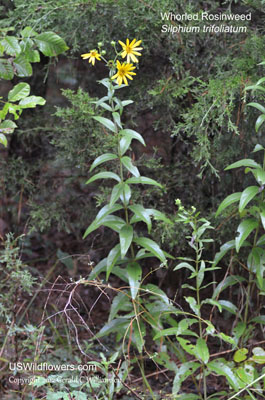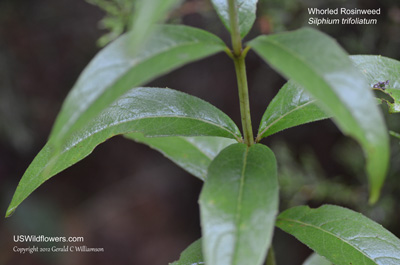Whorled Rosinweed, Three-leaved Rosinweed - Silphium trifoliatum
|
Silphium trifoliatum - Whorled Rosinweed, Three-leaved Rosinweed. Silphium triofliatum is listed as a variety of S. asteriscus in Flora of North America, but ITIS continues to list it separately, although no longer with varieties, formerly var. trifoliatum and var. latifolium. Var. latifolium has opposite rather than whorled leaves. I expect that when all the updating is done, S. trifoliatum will be gone, and listed only as varieties of S. asteriscus.
Endangered in Illinois
Found in:
AL, DC, GA, IL, IN, KY, MD, NC, NY, OH, PA, SC, TN, VA, WV
Leave comments on Silphium trifoliatum at this link. | 
Distribution of Silphium trifoliatum in the United States and Canada:

Blue=Native; Grey=Introduced
Map from USDA Plants Database:
USDA, NRCS. 2017. The PLANTS Database (http://plants.usda.gov, 08 May 2025). National Plant Data Team, Greensboro, NC 27401-4901 USA.
Search Our Database: Enter any portion of the Scientific, Common Name, or both.
Do a general Google search of the entire site:
#ad
 Follow USWildflowers on Twitter
| | Site: Wilson County, TN Date: 2012-August-04 | Photographer: Gerald C. Williamson
Nikon D7000
Tamron AP AF 90MM Macro | | Whorled Rosinweed has 8 to 13 yellow ray flowers. The ray flowers of Silphium develop the seeds; the disk flowers are sterile. | | 
| | Site: Wilson County, TN Date: 2012-August-04 | Photographer: Gerald C Williamson
Nikon D7000
Tamron AP AF 90MM Macro | | Whorled Rosinweed grows to about 6 feet tall and has leaves all the way to the inflorescence. | | Click on the photo for a larger image

| | Site: Wilson County, TN Date: 2012-August-04 | Photographer: Gerald C Williamson
Nikon D7000
Tamron AP AF 90MM Macro | | The smooth, usually glaucous stem of Silphium trifoliatum has mostly whorls of 3 leaves - occasionally opposite or rarely a whorl of 4 - which are nearly sessile (very short petioles) and narrowly ovate. The leaves have very shallow teeth or may be entire. Silphium brachiatum is similar, but with opposite lanceolate leaves having cordate or truncate bases, and fewer ray flowers. The distribution of S. brachiatum is also much smaller, being limited to a few counties in Alabama, Georgia, and Tennessee. | | Click on the photo for a larger image

|
References used for identification and information:
|
|
| |
| #ad
|
|





